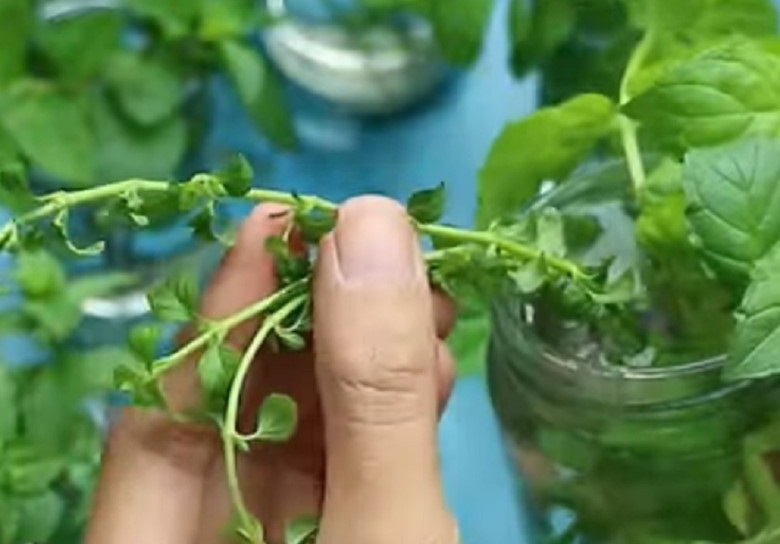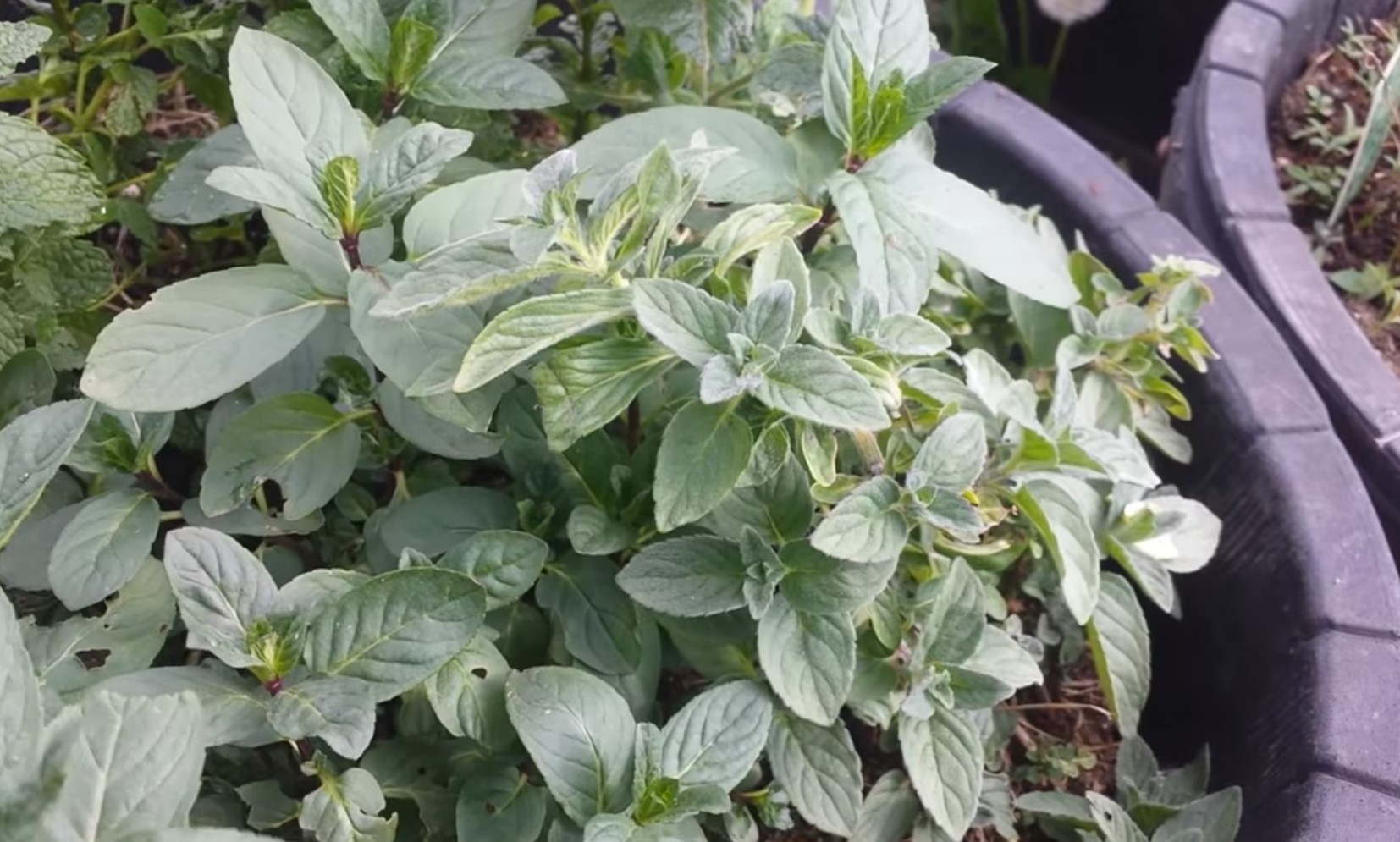Mint plants renowned for being a great addition to some beverages and desserts, all types of mint plants are worth growing. Read on to find some well-known varieties that you can plant at home.
1. Apple Mint

Apple mint (Mentha suaveolens), also known as fuzzy mint or woolly mint, is a fantastic herb. Besides, it comes with various culinary, medicinal, and decorative uses, thanks to the pleasing scent of it.
Furthermore, these types of mint plants do not require complicated maintenance. Thus, they will thrive well in rich soil that has a pH of 6 to 7 and offers good drainage. Also, the cultivars need a lot of suns.
Thereupon, it would be better if you grew these varieties in a container because they tend to be invasive, just like the other types of mint plants.
2. Pepper Mint

You might be familiar with these types of mint plants because you usually find them as the flavoring in chewing gum and toothpaste. So, what is peppermint?
Indeed, peppermint (Mentha x piperita) is an experimental hybrid of spearmint and watermint. Unlike many other varieties, this one requires more care.
As a good rule of thumb, peppermint requires a lot of water. Its natural habitats are by streams and ponds, so it is important to emulate this condition by growing it in rich soil that has proper drainage.
Peppermint can grow in partial sun. If you want to optimize the potency so that you can get high-quality oils and medicines, try planting it in full sun.
Related: How to Pick Mint Leaves Without Killing the Plant
3. Chocolate Mint

Have you ever wondered whether peppermint with the aroma of chocolate exists? Yes, it does!
The lineage of chocolate mint seems confusing. It is derived from spearmint, watermint, and orange mint. Therefore, it becomes a close relative to peppermint.
As the name suggests, these types of mint plants have the aroma of chocolate. However, when you add them to a food, you will get a hint of orange citrus flavor.
People use chocolate mint to add flavor in desserts and drinks. Also, you can incorporate it into your yard landscaping as it produces beautiful lavender flowers in summer.
Additionally, as a bonus, it can make a great ground cover.
4. Banana Mint

Mentha arvensis comes in the form of small bright-green leaves that have a wonderful aroma and taste of banana. Wherefore, in summer, you will find clusters of small lilac flowers that attract bees.
People usually use it as an ingredient in cookies, ice creams, fruit salads, and muffins. Then, you can grow this mint at home by placing it in a partly shaded area. Just make sure it is moist.
However, you have to be careful if you keep pets at home because it is toxic to cats and dogs.
5. Lavender Mint

These types of mint plants have a red stem and striking flowers, which makes them worth adding to your front yard landscaping. Hence, they can perfectly enhance the curb appeal of the house.
Just like many other types of mint plants, this variety is quite invasive. Therefore, it is a good cultivar if you are searching for a spectacular groundcover.
Moreover, you do not need to worry about whether it can thrive well under a big tree because it tolerates shade.
In addition, lavender mint usually becomes one of the essential ingredients of some personal care products, such as shampoos, creams, and lip balms. Besides, you can dry and add it to your tea.
6. Watermint

Watermint, also known as aquatic mint, usually grows along the edges of the water. Therefore, it can thrive well in slightly acidic, loamy, and moist soil.
Likewise, you had better plant it in the area around a pond so that the roots can constantly absorb the moisture.
This variety features thick dark-green leaves with a hint of purple. Also, they are slightly hairy and deeply veined.
Further, watermint produces tiny purple or blue florets that add fragrance and attract pollinators in summer.
7. Licorice Mint

Licorice has pointed leaves that look like spears with toothed margins. Besides, it produces lavender-purple flowers that can reach 20 centimeters in height.
Both the leaves and flowers are edible. Therefore, people usually use them as a garnish.
The dried leaves are great for making tea. Also, try chopping them to add more flavor to your green or mixed fruit salads.
8. Slender Mint
Slender mint (Mentha diemenica) is native to Australia. It thrives in a slightly damp area and requires full sun. Otherwise, if providing much light is not possible, it can tolerate heavy shade.
These types of mint plants are frost hardy. However, it is prone to a rust fungus that can possibly cause small brown spots on the leaves. Thus, to overcome this problem, try using a suitable fungicide.
9. Spearmint

Spearmint varieties are types of mint plants that produce a pleasant smell. Therefore, many people use Mentha spicata in health-food products, mouthwashes, cosmetics, and toothpaste.
Also, these plants are beneficial for medicine due to their therapeutic properties.
Many people compare this variety with peppermint due to the similar aroma. However, spearmint contains less menthol, yet has a sweeter taste. Besides, it is rich in dihydrocarvone, cineol, and limonene.
Furthermore, spearmint has several health benefits. People use it to alleviate digestion disorders, such as indigestion, diarrhea, nausea, and gas.
10. Pennyroyal Mint

Are you going to throw a backyard movie party? You had better make insect repellent out of pennyroyal. This mint type is your go-to herb if you want to kill germs and treat skin diseases.
People also use it to lessen venomous bites and mount sores, and relieve gastrointestinal discomfort, menstruation problems, and pain.
You have to be careful, though. Pennyroyal can induce abortion. Therefore, a pregnant woman must not handle or consume it.
11. Egyptian Mint Plant

Egyptian mint (Mentha Niliaca) is an ancient variety that has existed since the Pharaoh’s times. This plant is similar to an apple mint, both smell and taste.
Further, it features sturdy upright stems with large velvety leaves.
People usually use these types of mint plants to add flavor in savory dishes and teas. Also, they make a great skin toner.
This mint type is rather tall. Therefore, you had better grow it in a medium or large pot.
12. Corsican Mint

Corsican mint (Mentha requienii) features tiny round leaves that can produce a powerful, minty aroma when you bruise them.
Since it is a ground-hugging plant, Corsican mint is suitable for covering the areas around stepping stones or pavers. However, you cannot use it in any site with heavy foot traffic.
Furthermore, you can grow Corsican mint indoor. Just make sure you use well-drained potting mix and a pot that features good drainage.
Place it in the area that allows it to get morning sunlight. However, it does not tolerate intense light and heat.
13. Horsemint

Horsemint, also known as silver mint, is an herb that produces pale-pink or lilac-colored flowers and hairy foliage.
People usually consume the fresh leaves and seeds or cook them. Besides, you can use them to add flavor to your salads and chutneys.
Try making herbal tea with the leaves. Many people believe that it can treat headache, digestive disorders, and fevers.
14. Strawberry Mint

Strawberry mint is a compact variety that looks great in any containers and hanging baskets.
As the name suggests, this hardy perennial features the scent of strawberries. Thus, this small green leaves and lilac flowers will thrive well in partial shade.
15. Eau De Cologne Mint Plants

These types of mint plants are also called orange or bergamot varieties because they feature leaves with citrus aroma. Therefore, it is renowned for being a great insect repellent.
Besides being an insect repellent, the aromatic attribute of Eau de Cologne mint usually becomes an ingredient in the preparation of sauces, salads, and jellies.
16. Catnip

Catnip cultivars are the types of mint plants that contain nepetalactone, a compound that cats love. Try rubbing a scratching post with the leaves.
Otherwise, try making a toy with the leaves to make your cats stop clawing furniture. Besides, this variety can repel insects. Not bad, right?
17. Grapefruit Mint

Grapefruit mint offers a tangy flavor that you can add to a wide array of different foods. It is your safe bet when you want to grab a refreshing beverage after working out.
Therefore, just freeze the leaves in ice cube trays, and put some into your water.
18. Lemon Balm

This mint type has the aroma of lemon. Many people use it to improve mood and cognitive function, reduce anxiety, relieve stress, and ease sleep disorder.
19. Catmint

Do not confuse catmint with catnip. They belong to different types of varieties.
It is obvious that catmint has beautiful flowers, whereas catnip features a weedier appearance. The former has lavender blooms, while the latter is white. However, both of them attract butterflies and bees.
20. Mojito Mint

This variety features a warm and mild flavor. As you can guess, this is one of the main ingredients of that popular Mojito cocktail.
21. Ginger Mint Plants

Ginger mint has a hint of ginger-like scent. It is usually used in Vietnamese cooking to add flavor to beef and chicken dishes.
Above all, you have known that there are a lot of types of mint plants. Which one is your favorite?
Related: 7 Things about Growing Hydroponic Mint That You Should Know
Which types of mint plants is best ?
Mentha spicata is the best variety of mint for your garden. It’s not as strong as peppermint or spearmint. It has a light minty flavor and it grows well. You can grow it in your yard or in a pot. You can add it to a mixture of dried herbs and use it in herbal teas and desserts.
Conclusion
In conclusion, most mint plants require high temperatures and a lack of humidity to grow well. These plants don’t survive outdoors in colder climates, where temperatures are below 20 degrees Fahrenheit and relative humidity is above 40%. Mint plants do best when kept indoors during the cold season, but do best when grown with some room to dry out naturally.
